Wedding
Marriage is a special time because it is the one ritual that can be controlled. One cannot set the date of birth or of death, but the time of the wedding can be negotiated between the bride’s family and the family of the groom and the whole village can prepare and participate. Villages weddings are still enormous, with several hundred guests routinely attending. Village weddings also last for days, usually from Friday through Monday.
Because weddings are the most subject to control, they reflect changes in culture more readily than other rituals. In the case of weddings, what used to be the mere registration of the marriage became, in Soviet times, an elaborate civil ceremony conducted in the village club. This ceremony is practiced today, even as the church wedding has been reintroduced. Weddings readily reflect cultural adaptation to change. Through weddings, Ukrainians also express their new, post-Soviet identity. Thus, many are now making it a point to wear traditional costume for at least part of the wedding, as well as to bake a korovai and stand on a rushnyk.
I have been documenting weddings in Central Ukraine since 1990 and in 2009 a student at the University of Alberta, Yanina Vihovska, took many photographs and made videos of a wedding in her village of Pidhaitsi near Lutsk in Western Ukraine.
——————————————————————————–
Weddings in Central Ukraine
——————————————————————————–
Courtship and Proposal
Marriage is preceded by courtship. In the past, as recently as 50 years ago, courtship was heavily ritualized. Women of marriageable age, usually past 16, would get together and rent a house, paying for it with food and their labor. They would gather in this house from October, after Pokrov, until Easter. They would do chores such as spinning. Part of the thread that they spun could be donated to their hostess as payment. Boys would join them later in the evening. Entertainment consisted on songs and games. On major calendar holidays, the young people would prepare a large meal and their party would be joined by older children and young married couples. In the summer, courtship events were held outdoors, on village corners. Here too young people would sing and dance and court one another.
With the Soviet period, there was an effort to control ritual activity, courtship included. The klub, a club officially intended for the enlightenment of the population and for activities in service of the Soviet state, was introduced into the village. Khrushchev’s 1950’s building campaign did bring the klub to most villages where it became a social center as well as a Communist one. The klub was the place where civil weddings were and are still held. Activities aimed at the young, those intended to facilitate courtship, include events such as disco night, movie night, and so forth. These continue into the present. We have worked with Zina Ivanivna Litovka, the head of the village klub in Ploske for a number of years. We went with her to some of the events for the young and there is a photograph of disco night taken in 2005. The klub is supported by the municipal government and some villages were not able to continue to support their klub once the Soviet system collapsed. In some of these, such as Dobranychivka, the function of the klub has been taken over by the local store which built on a café and later added a hall for dances and movies.
The Proposal.
The proposal was a ritualized act. Once the couple had agreed to marry, they set a date when the young man would approach the woman’s family and make a formal marriage proposal. He was supposed to take two married men with him and go to the woman’s house on the designated date, carrying a bread and a bottle of horilka. In some areas, he waited outside while his two emissaries made the request for him. In some, he entered with them, but did not speak. If the proposal was accepted, breads were exchanged. Then all would celebrate with the horilka brought by the groom’s party and a meal which had to include the breads provided by both sides.
This formal marriage proposal is still preformed in most villages. The big difference is that the groom and his party travel by car instead of walking the village streets on foot. Some villagers complain that, with the introduction of cars, it is not as easy to tell who will marry whom.
In the past, there were two additional steps to the pre- wedding phase. One was the inspection of the groom’s household where the bride’s family assured themselves that their daughter would be well taken care of. The other was the agreement about the wedding proper. At this event, called the domovyny, the bride’s family and the groom’s discussed how many people would be invited by which side, what gifts would be given, and so forth. Domovyny are still practiced today, while the ritual inspection of the groom’s household is gone. The wedding itself happens soon after the domovyny, usually in one week to one month.
——————————————————————————–
The Korovai
In the week leading up to the wedding, ritual baking takes place at both the bride’s home and the groom’s. Married female friends of the household are invited and they bake the needed ritual breads, usually to the accompaniment of songs. The korovai is the centerpiece of the baking. It is the wedding bread that sits before the couple at the wedding banquet (photo from Mryn) and it is the bread that is distributed to all the guests. Depending on the region, other breads can also be baked. Most common among these are shyshky, small breads twisted into the shape of pine cones and used to invite guests to the wedding. We photographed the baking of a korovai in Mryn, Nosiv region, Chernihiv province in 2000.
After the baking, the bride (moloda) would walk the village with one or two attendants (druzhky). They would enter the home, leave a shyshka and issue their invitation. The groom did the same with his boiaryn and the shyshky baked at his home. In the Soviet era, print invitations became popular. People now mail invitations, but many have revived the custom of walking the village to invite their guests. Interest in things Ukrainian and attempts to revive Ukrainian culture are behind this trend. Some women have taken to sewing traditional costumes to wear at their weddings. The last picture below shows a photograph taken in 2005 of a woman in Iavorivka, Drabiv region, Cherkasy province.
——————————————————————————–
The Civil Ceremony
The civil ceremony is held in the klub on Saturday. During the Soviet era, the civil ceremony was the only possible wedding ritual. While not legally banned, church weddings were rare because most churches were destroyed and having a church wedding was likely to ruin job prospects. Because the civil wedding was the central event, it acquired many ritual trappings, including a speech read by the klub head or other civil servant, songs, and the breaking of a bread, usually a korovai, over the heads of the couple. The couple stood on a ritual towel and the person conducting the ritual would tie their hands together with another ritual towel or rushnyk.
While most weddings now have a church service as well as a civil one, the civil service has retained its importance. After the civil service, the couple visits the village monument to soldiers fallen in battle and lays a wreath or bouquet there. There is typically a banquet following the civil service.
——————————————————————————–
The Church Ceremony
Prior to the Soviet period, the church wedding was held on Saturday so that the couple could attend Sunday mass the next day as a wedded pair. With the introduction of the civil wedding and the reintroduction of religion in the post-Soviet period, the church wedding now takes place on Sunday. Another banquet typically follows the church service.
——————————————————————————–
The Folk Component
The folk component of the wedding is worked in around the civil and church ceremonies. Sometimes it follows the civil ceremony, as in Krut’ky and sometimes it precedes it, as in Mryn. Important components of the folk ceremony include a procession from the groom’s home to fetch the bride. The procession, called a poizd or train, has some of the nature of a military parade and the members of the poizd can have military titles. Older men, tied with rushnyky and carrying staffs walk in front. They are followed by the groom, the boiaryn, and the svitylka, a female relative of the groom. The bouquet the svitylka carries is called a shablia or sword. The groom’s mother dispatches the wedding train, showering them with coins, grain, and candy. Along the way, the bride’s friends stage mock attacks and demand horilka as payment. When the train reaches the bride’s home, they have to bargain with the bride’s druzhka and pay money or horilka to gain entrance. In the home, flowers are sewn onto the groom’s lapel and that of the best man.
It is important to note that, under most circumstances, separate celebrations occur at the home of the bride and the home of the groom. Only the wedding train goes back and forth between the two houses. The rest of the wedding guests stay at the home of the person who invited them. Because literally hundreds of people are invited by each side, the families of the couple set up outdoor tents so that they can seat all of their guests at the banquet. These can be canvas tents or make-shift structures with a wooden frame covered by plastic garbage bags.
Another import folk element is the braiding of the bride’s hair.
This occurs in the groom’s home, during the banquet following either the civil ceremony or the religious one. The braiding of the hair is the folk symbol of womanhood and after the braiding, the bride is considered a wife and, when in public, must wear her hair covered.
Gift-giving occurs at the banquet and is another important folk element. The presentation of gifts can be accompanied by songs or rhymes, some joking and off-color. The bride and groom thank their guests for the gifts and offer them each a drink and a piece of korovai in return.
——————————————————————————–
Post-Wedding Celebration
On the morning after the wedding, the parents of the bride visit her in her new home, the household of her new husband. They bring gifts and acknowledge that their daughter is no longer part of their family. In some regions, the couple is first awakened by the groom’s family and friends and given a mock breakfast, foods that look good, but taste terrible. An example is pastries with raw vegetables, such as beets, inside. After teasing the couple, the family serves them a nice breakfast.
In the afternoon, most villages have a post-wedding carnival called the tsyhanshchyna. After the solemn wedding service, this is a raucous celebration with drinking and cross-dressing. Wedding guests dress as gypsies, doctors, or members of the opposite sex. Sometimes they capture either the parents or the godparents of the bride and groom and dress them in the clothes of the opposite gender. They parade the costumed elders through the street in a cart and dunk them in the river or other handy body of water. If the parents or godparents are not dunked into the water, they can be taken to the local pub and forced to buy everyone a round of drinks or other treats.
——————————————————————————–
Weddings in Western Ukraine
A wedding took place in the village of Pidhaitsi, on June 23, 2008. Pidhaitsi is in the Volyn region of Western Ukraine.
Many of the early settlers of the Canadian prairies came from Western Ukraine starting over 100 years ago.
The wedding was between Ruslan and Tania. Although Pidhaitsi village is only 2 km from the city of Lutsk, the village has maintained its own identity and customs. Even to this day a wedding is the biggest event that will occur in the village and everyone is involved in ensuring it will be successful. A key wedding symbol is the wedding bread, or korovai, and it must be prepared according to traditional custom.
For this wedding, the korovai for the groom was to be made at the house of the groom’s mother (Pani Hanna). She is a famous cook who has cooked at many weddings in Pidhaitsi and she invited four women to help, these women are called the korovainytsi. Only happily married woman can be involved in the baking which has to occur on Thursday (a male day).
——————————————————————————–
Purchasing the bride
Before going to the klub and getting married in the civil ceremony the groom has to purchase his bride first. In order to do so he has to follow many different traditions, such as: receiving a blessing from his parents and godparents, buying his passage during “perepojiny” (stops), bargaining with the bride’s family on a price that should be paid for the bride, and finally, he has to receive a blessing from the bride’s parents and godparents as well. After all of the traditions and rituals are observed, everybody goes to the klub. (Pidhaitsi village, 2008)
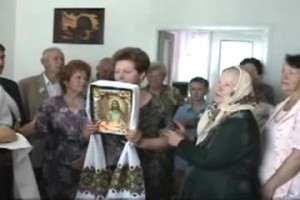 The groom has to bow three times and kiss the holy bread and an icon that his parents/ godparents are holding. |
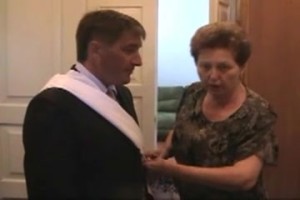 The groom’s mother ties a rushnyk over the right shoulder of the “druzhba” (the best-man at the wedding). |
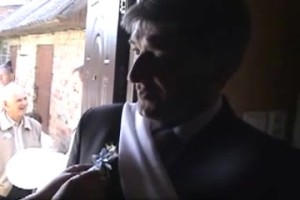 The “kvitka” symbolises a ticket to the wedding, and you need to pay the svashka when she is putting it on you. |
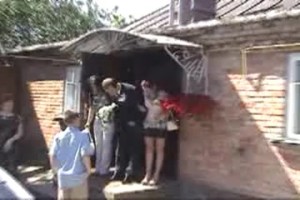 During the blessing procedure parents and Godparents walk around the cars three times and throw holy water on them. |
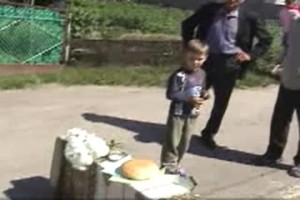 Passage can be bought with vodka or money. For the vodka, the druzhba gets a bouquet of flowers, and bread and salt. |
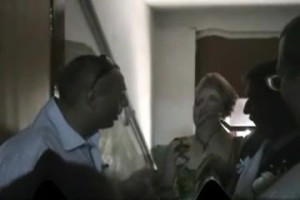 The groom and his guests came over to the bride’s house and her relatives start bargaining with groom’s druzhba. |
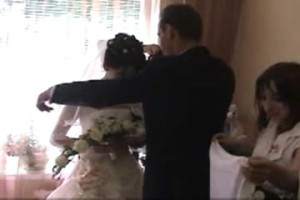 The whole wedding train is blessed again, this time by the bride’s parents and godparents. |
——————————————————————————–
The Civil Ceremony
The civil ceremony between Ruslan and Tanya was held on Sunday June 23, 2008 just couple of hours before the church ceremony. (Pidhaitsi village, 2008)
During the Soviet era, the civil ceremony was the only possible wedding ritual. While not legally banned, church weddings were rare because most churches were destroyed and having a church wedding was likely to ruin job prospects. Because the civil wedding was the central event, it acquired many ritual trappings, including a speech read by the klub head or other civil servant, songs, and the breaking of bread, usually a korovai, over the heads of the couple. The couple stood on a ritual towel and the person conducting the ritual would tie their hands together with another ritual towel or rushnyk. While most weddings now have a church service as well as a civil one, the civil service has retained its importance.
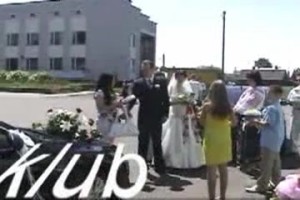 The best man enters the klub carrying a korovai in his hands. After him the bride and groom with their parents and guests. |
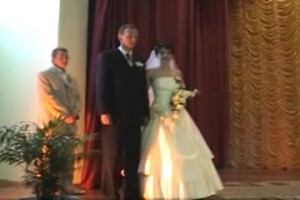 The woman in the beige costume is the official who will conduct the ceremony. |
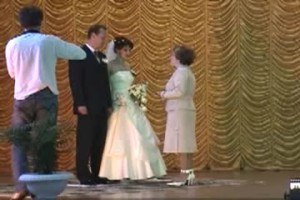 The couple stand on a ritual towel and official ties their hands together with another ritual towel (rushnyk). |
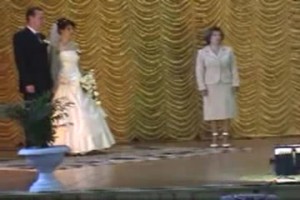 On stage with the bride and groom are al the parents and godparents, as well as a folk singing collective. |
——————————————————————————–
The Church Service
After the reception in the klub, the newlyweds go to the church to have a religious ceremony. In the past, when people celebrated weddings for two days in a row (on Saturday and Sunday), the church ceremony was always held on Sunday morning. This couple only had a single wedding day, Sunday, so after the klub all the guests followed the wedding train to the church. The service in the church usually lasts for 40- 50 minutes. During this ceremony two bridesmaids hold icons in front of the newlyweds and two groomsmen stand behind the couple holding the crowns.
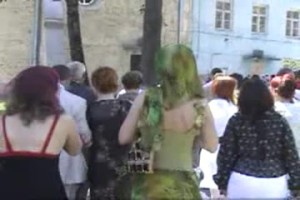
——————————————————————————–
The sightseeing and photo session
Usually after the church ceremony the newlyweds are going to different famous places in the city or village. In most cases they go to the monuments of famous people such as Taras Shevchenko or Lesja Ukrainka in order to put some flowers and take pictures. Also, it is popular to go to the photo studio and take professional photos. However, Ruslan and Tanya hired a professional photographer, so they had no need to go to the studio.
In Lutsk all the newlyweds go to the Lubart’s castle in order to take pictures. Ruslan and Tanya also went to the castle.
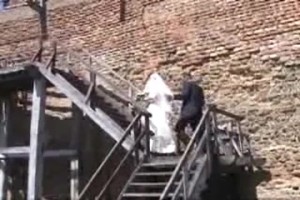
——————————————————————————–
The reception
Not so long ago, it was typical to see a village wedding reception held in a tent. At those, there were usually as many as 200 guests. A huge tent would be set up near the groom’s or bride’s house and decorated with balloons and flowers (for example, see one of the pictures from the wedding in central Ukraine). Nowadays, the newlyweds more often celebrate their weddings in reception halls or restaurants. Tanya’s and Ruslan’s wedding was no exception, it was celebrated at a restaurant. They invited 140 people to the restaurant reception. Quite often, the wedding guests will only come to the reception, and not go to the ceremonies at the church and klub.
The first thing you see when you enter the reception hall is a table with all of the Korovais.
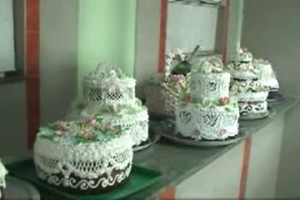 The Korovais. |
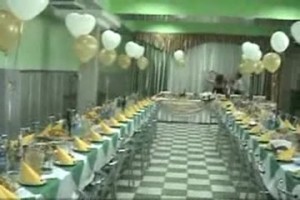 The Tamada invites the newlyweds to taste bread with honey, they bite slices from each side and pass it on. |
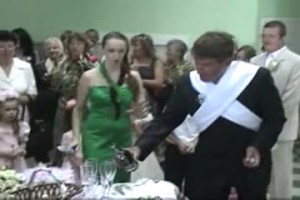 The druzhba opens a bottle of champagne and pours it into the glasses for the newlyweds and their parents. |
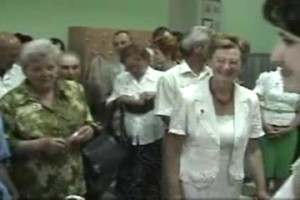 Usually, each guest has to kiss the bride and the groom on their cheeks. |
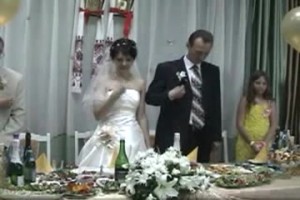 When the newlyweds are at their place, everybody stands for the traditional prayer. |
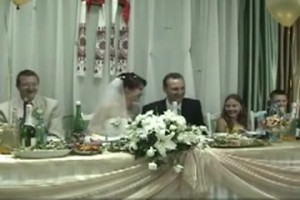 During the dinner, guests scream “Girko” many times to the newlyweds. Each time they have to stand up and kiss. |
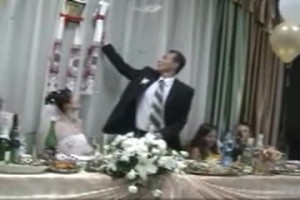 The Tamada sings many traditional songs, usually amusing. This is one of the songs that was sung. |
![]()
Even though the wedding reception does not take place in the traditional tent, most of the traditional Ukrainian wedding customs are still followed. In addition to the old customs such as the bride dancing with all the unmarried girls and the removal of the bride’s veil by the mother-in-law, nowadays we can see a slight shift to the North American wedding traditions as well. Possibly, this shift was influenced by the popularity of American media. The most recent of these adopted traditions are the tossing of the bouquet and the first dance of the newlyweds.
The second part of the wedding reception incorporates both old and new traditions.
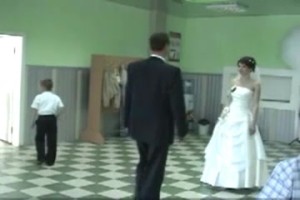 Usually, after the first dance, the newlyweds invite their parents to join them. |
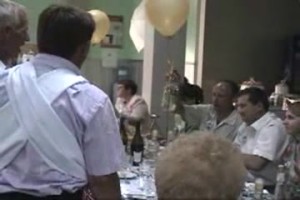 The singing often becomes very loud and intense. |
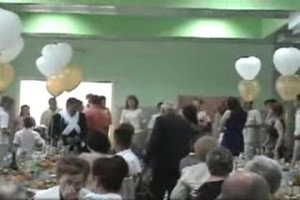 While people are still eating, others are dancing. They dance and sing until it is time to go for a second dinner. |
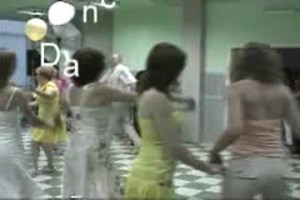 Both of them are kissing each other, anyone inside the circle when the music is over has to kiss all the musicians. |
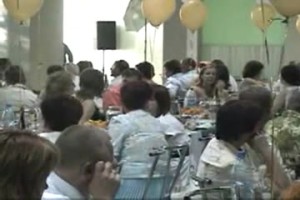 The musicians play a traditional march so the guests will sit down for a meal: cabbage rolls, potatoes and pirogues. |
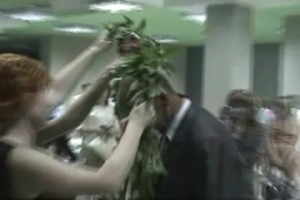 Each parent gets a flower chaplet before he or she is getting a famous wheelbarrow ride. |
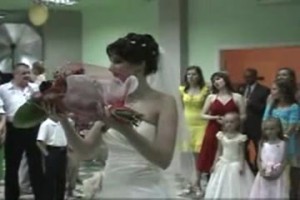 The bride picks one of the bouquets from those given by guests, not the bridal bouquet, and throws it into the crowd. |
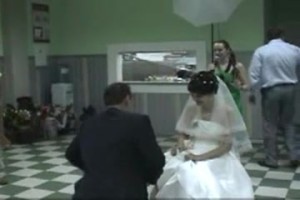 Ukrainian weddings now include a garter tradition. Here we can see how Ruslan is removing a garter using his teeth. |
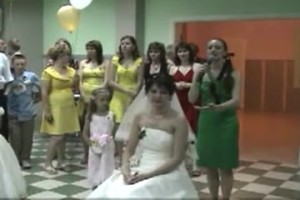 This ceremony is very moving, it symbolises the maturation of the bride. She should try to escape from the shawl. |
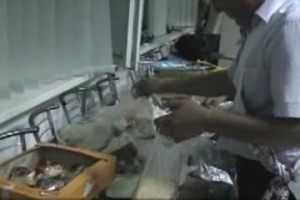 The pieces of the korovaiis are placed into plastic bags, so all of the guests can take one bag per family. |
——————————————————————————–
The After-party or Pyrohy
On the day after the wedding, close friends and relatives gather at the groom’s house for a “Pyrohy” party. Usually the guests eat left-overs from the wedding, sing old Ukrainian songs, and dance. Traditionally, guests should actually be fed pyrohy, but now it is rare that this tradition is followed, since it is very time consuming to bake enough pyrohy for every guest.
During this party it is common to see examples of role-playing and cross dressing. The “bride” has a ball underneath her dress. She was imitating the late stages of pregnancy. Usually it is a very loud party where everybody has a wonderful time.
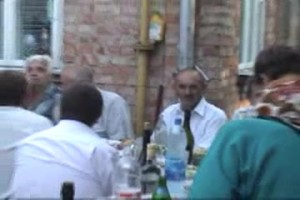 The guests are singing songs and eating at the Pyrohy party in Pidhaitsi village. |
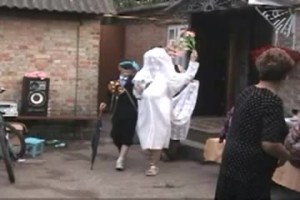 A cross dressed couple is introduced as the newlyweds. They start dancing and doing funny things. |
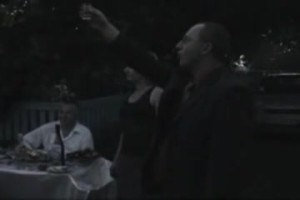 A guest toasts the parents of the groom; they married-off their last child and flower wreaths decorate their chimney. |




























































































